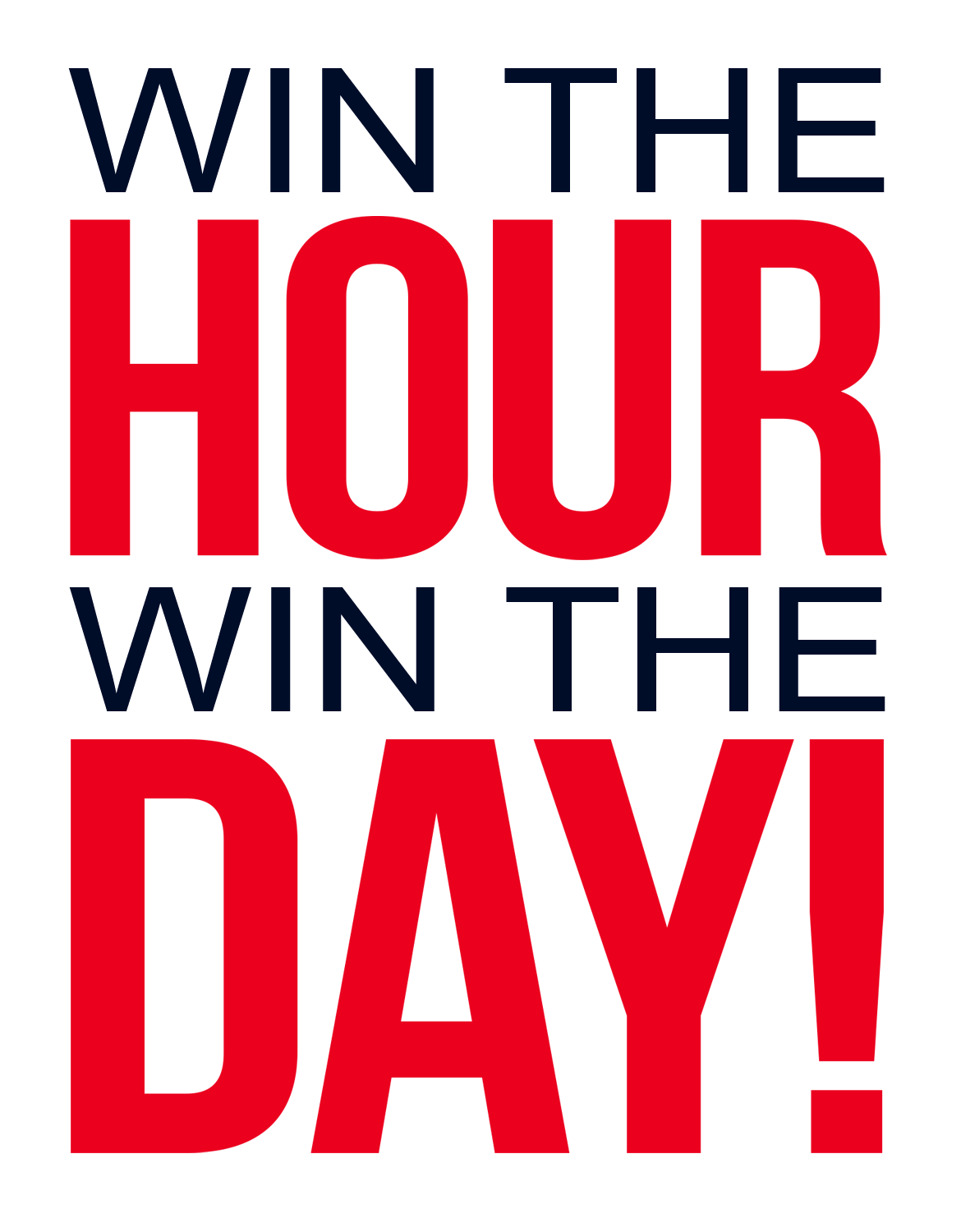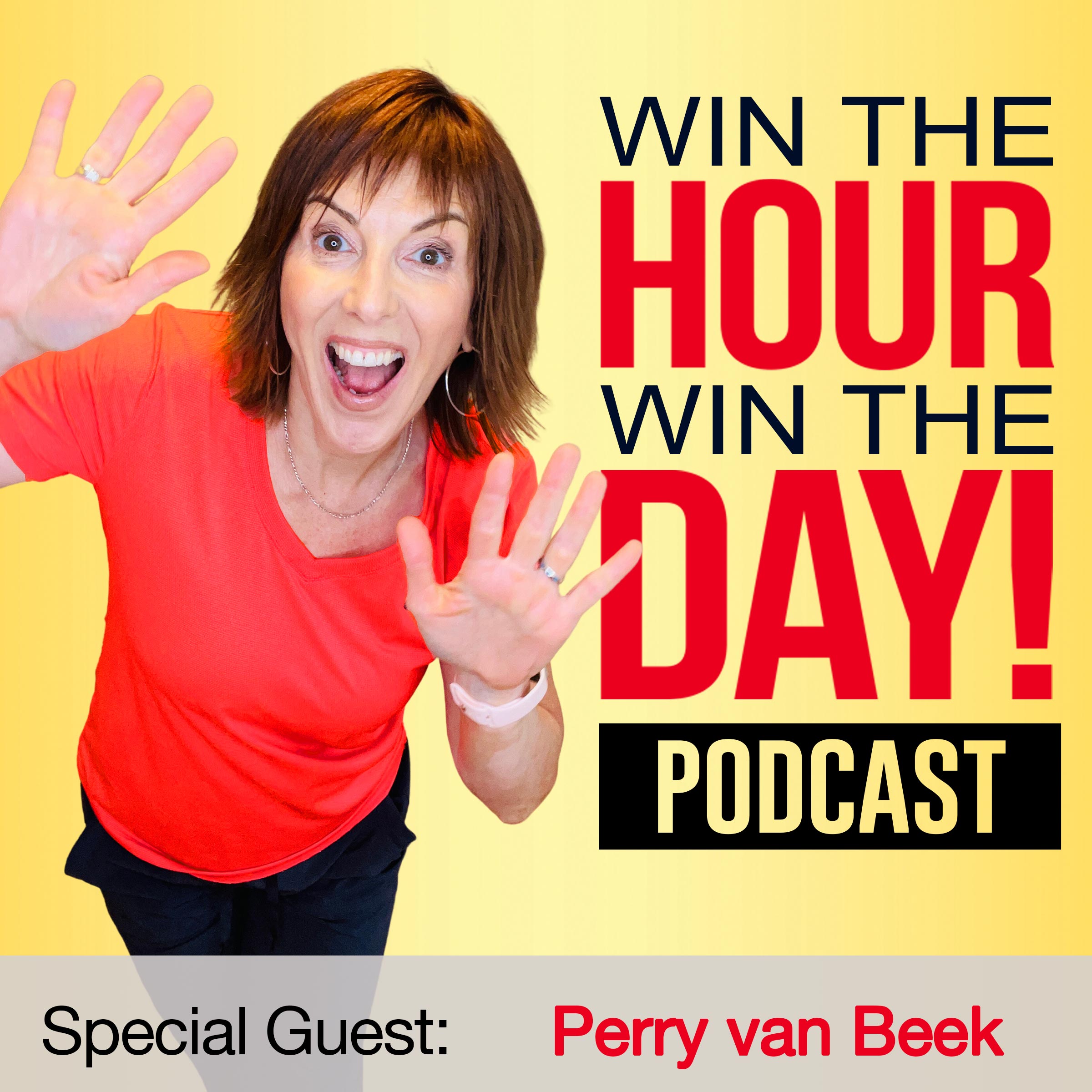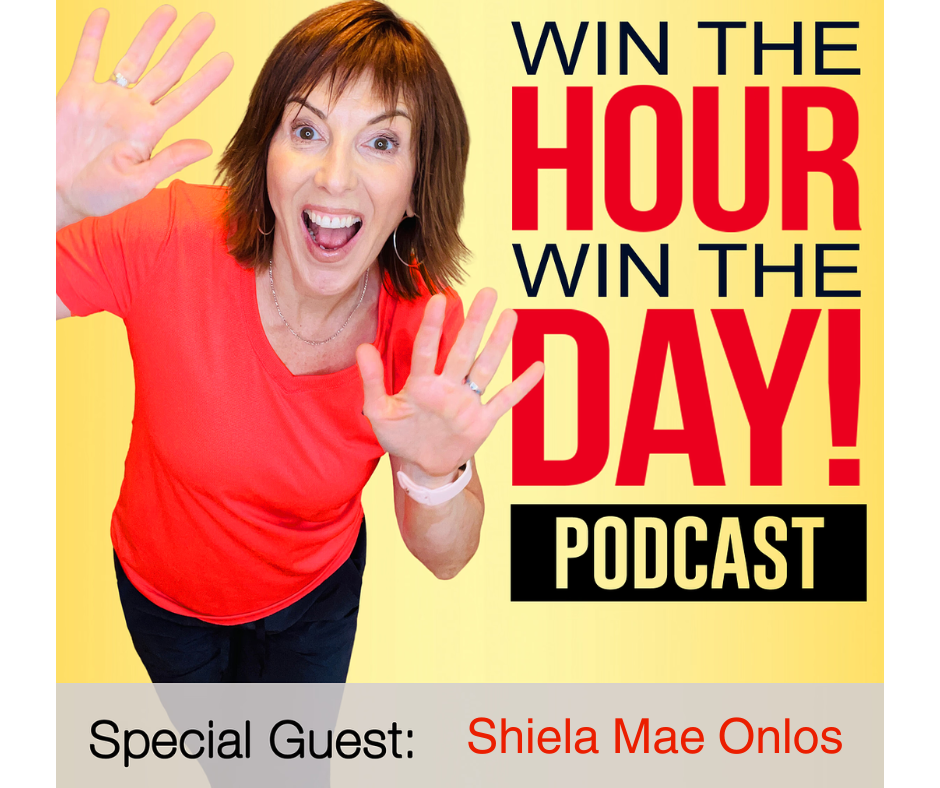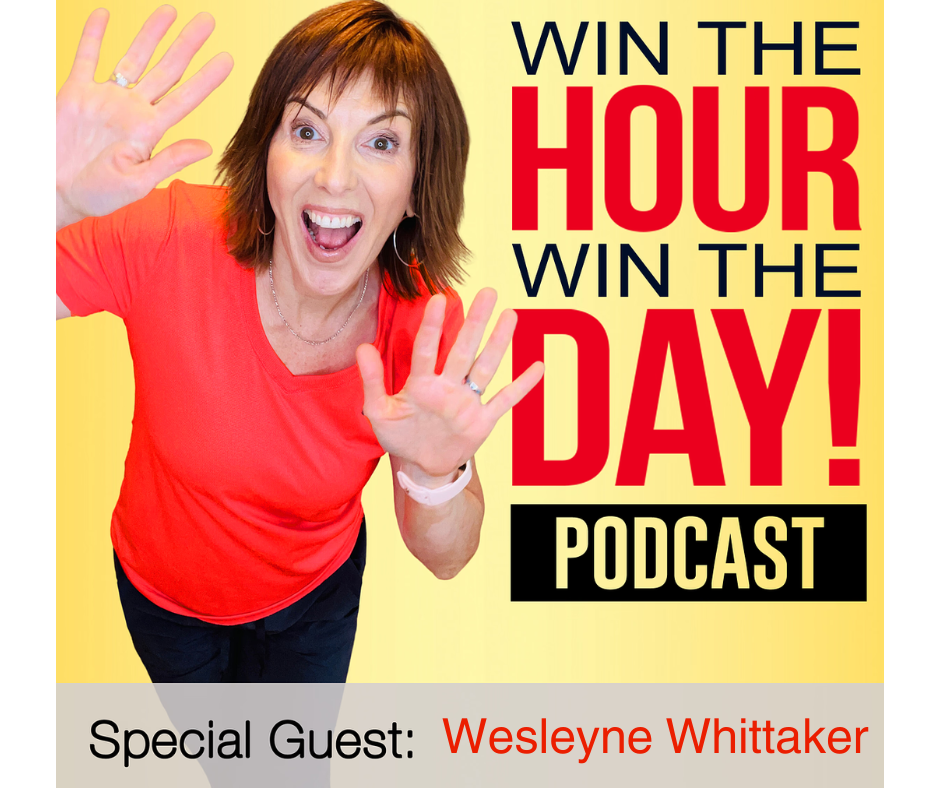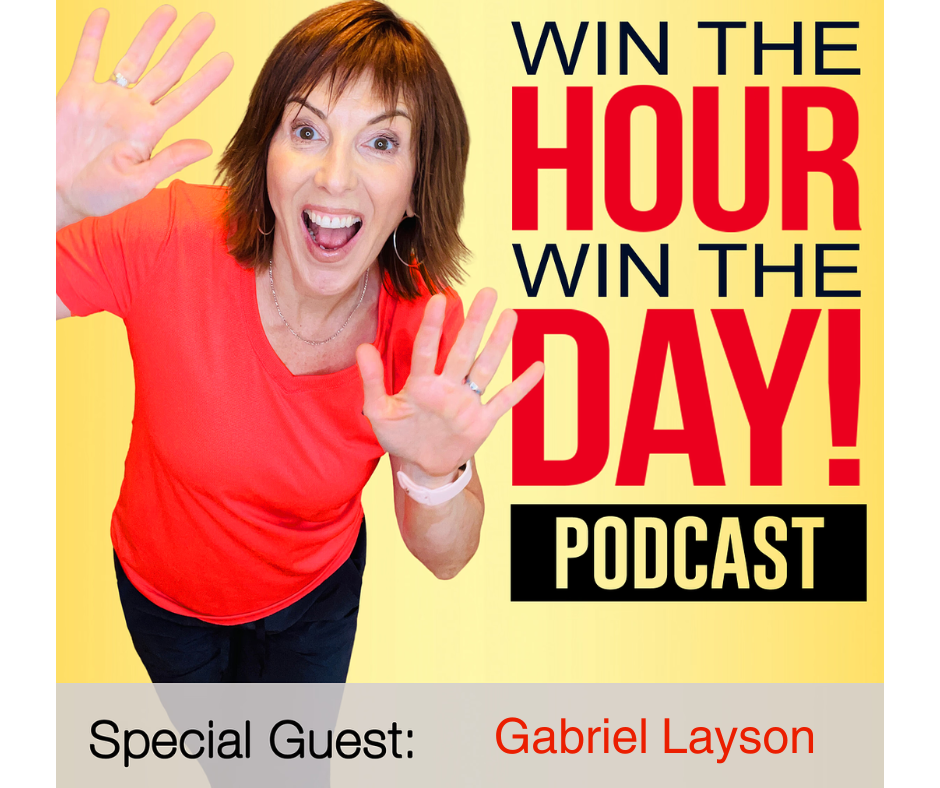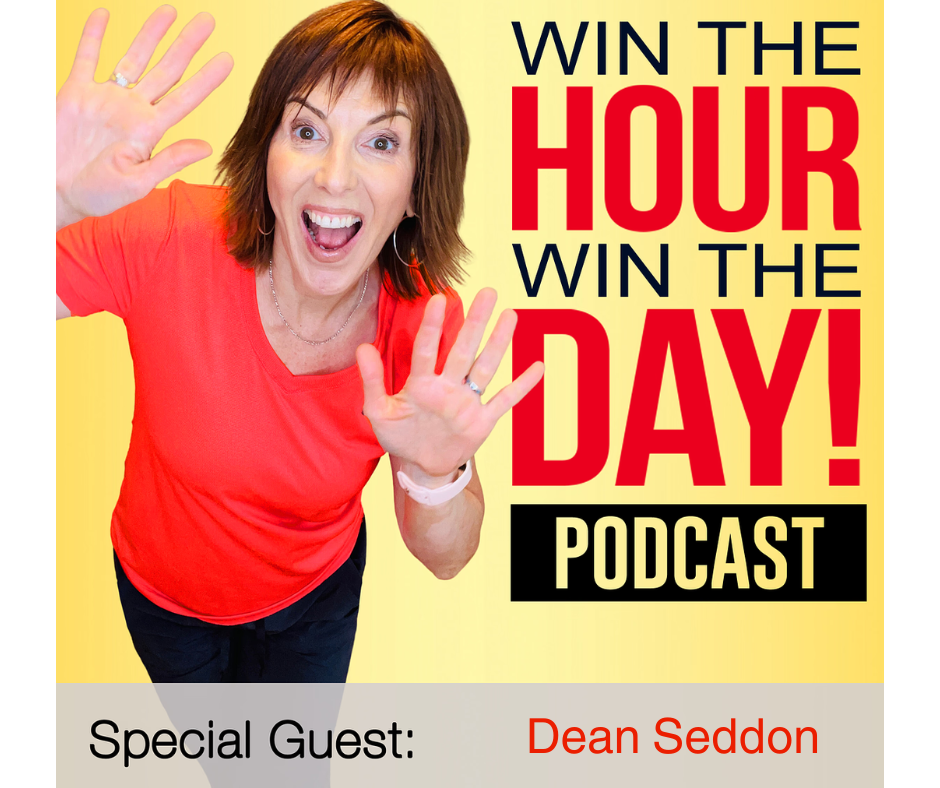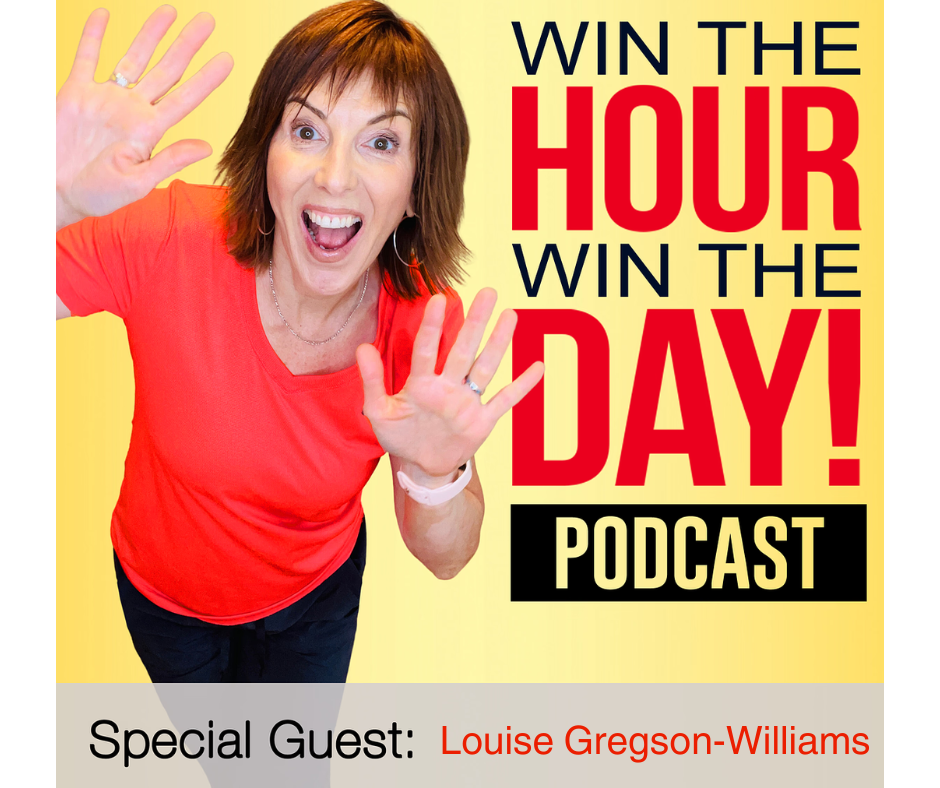Episode Summary
This week’s episode of Win The Hour, Win The Day Podcast interviews, Perry van Beek.
Unlock the full potential of LinkedIn with Perry van Beek, the Sales Navigator expert. In this insightful episode, you’ll discover:
-Why LinkedIn is more than just a sales tool.
-Strategies to enhance your networking on LinkedIn.
-The power of personalized connection requests.
Dive into the essentials of building valuable professional relationships and boosting your LinkedIn efficiency. Don’t miss these expert tips to revolutionize your approach!
Power Personality Quiz! http://winbacktimequiz.com/
Win The Hour, Win The Day! www.winthehourwintheday.com
Podcast: Win The Hour, Win The Day Podcast
Facebook: https://www.facebook.com/winthehourwintheday/
LinkedIn: https://www.linkedin.com/company/win-the-hour-win-the-day-podcast
You can find Perry van Beek at
LinkedIn: https://www.linkedin.com/in/perryvanbeek/
#KrisWard
#LinkedInVideoTips
#NetworkingSuccess
Win The Hour Win The Day
https://winthehourwintheday.com
Perry van Beek Podcast Transcription
[00:00:00] Kris Ward: Hey everyone. Welcome to another episode of Win The Hour Win The Day I am your host, Kris Ward. And today in the house, we have Perry van Beek.
[00:00:07] That number one sales navigator guy, we’re going to talk all LinkedIn, but listen, it’s going to be dynamic. It’s going to be interesting. And we, yeah, we’ll dabble a little bit into sales navigator. Welcome to the show, Perry.
[00:00:21] Perry van Beek: Kris, thank you for having me. I’m such a big fan of your show.
[00:00:24] Kris Ward: Oh, you’re very kind.
[00:00:25] Okay. So let’s talk about LinkedIn. Let’s go broad first. All right. So I think it is getting far more robust, far more inviting. It’s how we met. It’s not the dry thing it used to be. So to start with, what do you think we really need to be mindful of when we’re in LinkedIn? What are we missing? Where do we start?
[00:00:45] Perry van Beek: First of all, whether you’re in sales or whatever role you’re in, LinkedIn is not a sales platform. Even though we use it for to make new connections, stop selling on LinkedIn. It is not there for LinkedIn basically is it is giant network events. With right now you have 1 billion people there.
[00:01:05] The only difference is you got to bring your own drink. But there’s, you can meet all everybody that you want, you’re everybody’s open to, but don’t start selling it just this morning. I got somebody, I’ve never heard of him. And he starts sending me, why don’t you invest in my company?
[00:01:19] We were looking for, I think 50, 000. I didn’t even read the full message because it was like, what are you thinking? The networking event, would you ever walk up to somebody and say, “Hey, Yeah. Can I have 50, 000 to you?” No, this is the real world. LinkedIn is the same as the real world. That’s basically my core message.
[00:01:38] Kris Ward: Okay, hold on. Let me jump in there because I don’t want to spend too much time on that because there are crazies in every room, right? So I get sometimes too, and it does give LinkedIn a bad name. But I don’t know why because Facebook was no better. I remember back in the day, I don’t know if you can tell by looking at me, Perry, but I am smoking hot in Nigeria.
[00:01:55] I don’t know what I was doing, But the Nigerians love me and, here I could get married and date and all this stuff. So every platform has, it’s crazy. And that’s that one thing, but taking the craziest side, I think you do have a point. It is a networking thing. Bring your own drink. And really just looking to build relationships.
[00:02:13] And I know we’ve talked about this with other people, but I think you almost need to be reminded of that. Like you just, every day you have to go cause it’s so easy to hop onto LinkedIn, spend a little time there and then be deflated that maybe nothing exciting happened, but nothing does, nothing exciting does happen when you’re building relationships. It’s a process. It takes a little bit of time.
[00:02:34] Perry van Beek: Yeah you can make it exciting, yes. Okay. So I would say, there’s no traffic jam in the extra mile. So look, take that step further. If you, if I look at your profile, if I look at the profile of a prospect and I find something, I find, for example, that he used to play rugby or something like that, I would.
[00:02:52] Start a conversation on that and make it a bit more exciting. I’ll make it personal more, so like I said, the reason for my wild hair today is my motorbike. So if I find on somebody’s profile that they love motorbikes as well, let’s, that’s for me, that’s a reason to connect, so to look for that, go for that extra mile.
[00:03:10] And it’s, I was telling you before, we, you said, I always personalize my connection request and I fully agree with that. I fully agree with that. But I did a test with a fellow, with a colleague of mine, with a Malfunar from the Netherlands. And I, we said, okay, we’re challenging each other.
[00:03:25] We’re going to connect with people without a personalized connection and then follow up with an in mail. So say, oh, I’m sorry. I forgot to personalize the connection request. We have 78 percent acceptance rate. 78 percent accepted because I connected with him without personalization and then followed up with an email and really made it personal.
[00:03:44] So now what we did find though, that it took a lot more time than we thought it would, on average about 15 minutes for a prospect. So yeah, it does take time, but you do not need sales navigator for that. That’s the whole. Okay.
[00:03:58] Kris Ward: So hold on, but let me back up for a second. First of all, I would like to repeat your quote.
[00:04:02] Cause I thought it was really good. No traffic jam in the extra mile. Write that down. Cause that’s great. Okay. That’s a nugget. All right. So let’s do that. And then when you say the in mail, I thought that was sales navigator. A, you’re saying you tried an experiment where you just reached out and did the automated connection without personalizing it.
[00:04:19] And when they did accept or before they accepted, you sent an in mail. Okay.
[00:04:24] Perry van Beek: Immediately after the connection request.
[00:04:27] Kris Ward: Okay. And so two things I thought in email still is part of the free part.
[00:04:33] Perry van Beek: No. That’s still free emails.
[00:04:35] Kris Ward: Okay. Okay. So there’s that. And so why did you do it that way? I know it was a bit of an experiment and took a little bit more time, but you just thought I’ll just send a bunch of stuff out and then you went to their profile and personalize it.
[00:04:47] It was just a different tactic.
[00:04:49] Perry van Beek: Basically we had an episode before that we had a discussion and we were talking about how useless in mails are and then somebody basically challenges. And they said, if you do it like this, they could help. And we were like probably not.
[00:05:01] And, but we’ll try it. And then basically, yeah.
[00:05:05] Kris Ward: And the in mail, I never really grasped that either too. So when I’m in LinkedIn, then there’s a LinkedIn message box. And then there is the LinkedIn sales navigator message box. Okay. Yes. The InMail. Okay. See, I don’t think even though I’m paying for Sales Navigator, I don’t think I’m in the InMail very often.
[00:05:22] So why do some things come into my InMail? Because I don’t, I haven’t been connected to them yet. Is that why they end up in InMail?
[00:05:30] Perry van Beek: It could be, but no. What I always recommend people do, if you have Sales Navigator, if you’re an entrepreneur, if you have Sales Navigator, do all of your communication in LinkedIn.
[00:05:43] Navigator, because the moment that you decide to cancel sales navigator, all that communication that you’ve had with that prospect or client or whatever is okay.
[00:05:52] Kris Ward: Okay.
[00:05:53] Perry van Beek: Okay. Do all of your communication on the regular LinkedIn. I think it’s still amazing that these two inboxes do not, do not match.
[00:06:00] On the mobile phone, you have some way of jumping in from one to the other, but it’s not, it’s, it should just be one, one unified inbox, but it’s,
[00:06:09] Kris Ward: yeah, it’s, that’s annoying. I’ll give you that. Okay. So when we’re talking about LinkedIn too, one of the things that you’re passionate about is on commenting.
[00:06:16] What are your thoughts on commenting on LinkedIn?
[00:06:20] Perry van Beek: Basically if you, to make a post on LinkedIn, you need a lot, you need to spend a lot of time, at least about two hours per post. It really takes some time. Oh, wow. Okay. Good post. You need to think about the title, the hook, to get people into what picture am I going to share with, or am I not going to picture, share a picture with it?
[00:06:37] Was it going to be video? Is it going to be carousel? What’s it going to be? So that’s a lot of work. Whereas a comment, it’s anywhere from five seconds to maybe two minutes and also there, they’ll go the extra mile. So if you start commenting on people, and I have a client who was very reluctant to post on LinkedIn, and I said okay let’s do the commenting.
[00:06:55] I call commenting. I call it sharing. I’m sorry. Posting on LinkedIn. I call it sharing commenting. I call it caring just simply sharing and caring. Okay. Now with regards to caring, I taught him how to do it. I taught him how to go on LinkedIn and start commenting on other people’s posts, relevant for his network.
[00:07:13] He had 1700 percent more profile views in one week.
[00:07:16] Kris Ward: Yeah. Yeah.
[00:07:18] Perry van Beek: And he’s What’s going on? I get all these connection requests and all these people visiting my profile. So why did that happen? Simply because he was adding value. To other people’s posts, he’s asking the right questions.
[00:07:30] He was asking, really initiating conversations. No, on public, and if, for example, if you share something on LinkedIn and I’m the first person to comment on that, I’ll ask you a question, you’ll summarize your posts and say, “Hey, so Kris, if you say this and this is did I understand correctly that you mean this and this, and what’s your take on this and this, if you don’t respond to that’s awkward even.”
[00:07:53] So the chances of you responding are huge. If I then respond to that again. My, my post or my comment will be on the top of your, of that post for everybody to see it. So I get a lot of exposure to your network.
[00:08:06] Kris Ward: I would, yeah. I will say I went through a recent transformation of I went through all these stages of LinkedIn.
[00:08:12] I like, it should be like six stages of grieving on LinkedIn and for a while, you’d scroll or I’d like or something. Yeah. I would just hit is that enough? And then I was hitting emojis, is that enough? And then I was making sure comments. And then recently, although I do feel like I was way on holiday, so I feel like I dropped the ball a little bit, but I went through a period where I was spending an hour every day on LinkedIn, putting very purposeful, detailed, thoughtful comments, and it really did skyrocket my profile views.
[00:08:39] I would also argue that I think I’ve got a couple of clients out of it because they just suddenly found me out of nowhere. And I do think it’s. Cause it’s hard to trace cause now you’re chatting with them and they’re like I found you here and I listened to your podcast, but it really did change the game.
[00:08:52] Like people, I feel like people are paying attention to me or they know me better or I know them, or there’s people on the radar now that weren’t on my radar before. So I was always previously just doing enough is this enough to get by? And now I changed my attitude and I went in with it’s one hour of Thoughtful and people will reach out and say, Oh my gosh, thank you for chiming in my post.
[00:09:13] Like they’re all just trying to do what we’re doing. Like we, so that was very nice to you. And then they reach out and they connect with me. And now, that’s a great way if nothing else to, we all hear be of service or whatever to get noticed being kind and even that’s fine. People are just so grateful when they put that post out, somebody commented.
[00:09:32] And I seem to be making more meaningful relationships that way. It seems very basic, but I’m telling you, it took me years to learn the hard way. Years. So I think you’re right there. You really are.
[00:09:46] Perry van Beek: And that’s exactly why I call it caring because you’re showing that you care about others and others will start to care about you. It’s really that simple.
[00:09:55] Kris Ward: Yeah. Okay. So B and another thing I’ve heard on this show, which I think is really helpful. You can’t control who is going to comment on your posts, but you can control and how many posts you comment on. So then you don’t feel like, ah, this is a flop because you have no control over anything.
[00:10:13] But I do think that my engagement has definitely gone up when I started being more sincere and focused about commenting other on others. Okay. So we want to do
[00:10:23] Perry van Beek: Because if I comment on your post and you comment on my comment, then if I post tomorrow, the chances of my post organically showing up on your timeline is huge.
[00:10:36] Because LinkedIn says, Hey, look, you two seem to like each other. So here’s Perry’s post. So that all makes sense. So that’s why, yes, if you do start commenting and people start liking your, and commenting on your comments, the chance that your posts are showing up on their timeline organically is so much greater.
[00:10:56] Kris Ward: Okay. So that all makes sense. And I think we just need to be told that almost every day as I work with entrepreneurs, coaches, consultants, small business owners, and founders, I’ve been doing this, helping them to get, 25 hours back a week within the first month and working with us. And we do all these wonderful things.
[00:11:11] Now, recently people really been pushing me saying, Kris, you need to be more in the corporate world, working with teams. And I have started to dabble with that a little bit. Here’s something that I don’t quite understand. is let’s say now, your business serves what I would call bigger, small businesses.
[00:11:28] And you want to start dabbling with companies. I know some people say follow companies, but what’s the advantage to that? How do you do it? Like I, that part, the bigger part of LinkedIn, we’ve never talked about here. And I think it gets confusing quick.
[00:11:44] Perry van Beek: Especially using sales navigator in sales navigator companies called accounts and it’s crucial that you really identify those accounts, especially if you’re targeting larger accounts.
[00:11:52] Sales navigator has this option called account IQ with the click of a button. And this is all companies that have 199 employees or more. LinkedIn will search the internet and find all relevant data about this company. So what’s important on this company? What are their, what are the updates?
[00:12:09] What are their business challenges? Who are their competitors? Who are the leaders within the go? So LinkedIn does the research throughout, and with the click of a button, you have all this information at your fingertips. So it’s really crucial to know now if you’re gonna reach out to senior people at that company, for example that may not be sharing content on LinkedIn at all.
[00:12:27] They may just be lurkers, and most, many people are just lurkers there, but you can use the information that you just found about the company when you reach out. Hey, I read this interesting thing about your company, and then you can ask a question about that.
[00:12:40] That’s a great way to, to, to initiate a conversation. Otherwise you can also see what is the company sharing, maybe one of the senior leaders has been in the news and you use that as a reason to connect. So use what the company is sharing or what’s news about the company to, to reach out to people because not everybody is sharing content on LinkedIn.
[00:12:58] So it’s, you can’t reach out to everybody just saying, Hey, great post, but I never posted. Oh yeah.
[00:13:05] Kris Ward: That’s our problem because. For us entrepreneurs, small business owners, we know the grind. We have to post whether we want to or not. But then if you’re dealing with smaller corporations and they have whatever, 20, 50, a hundred employees, those employees are just doing their job.
[00:13:20] They don’t frigging care about LinkedIn. They’re not doing that every day. So that was always the confusion to me. It’s okay, so I want to follow the company, but is that. Who am I following when I follow the company and then the people who work for the company, the HR person, maybe I want to do a speaking gig, but that HR person hasn’t posted in two years.
[00:13:37] They’re just on LinkedIn because they have to be under that company. So it gets a little confusing. So you’re saying look at their account IQ. We can do that through sales navigator. And then even though not posting, then get a little bit of information about the company and then reach out and message, let’s say message the HR person
[00:13:56] Perry van Beek: For example, it depends on who you’re trying to reach within that company.
[00:13:59] Kris Ward: Got you. Okay. All right. So we’ve talked about comments. We’re talking about let you, you steer the ship. What do you think we’re missing for the most part on LinkedIn?
[00:14:10] Perry van Beek: The thing is, like we talked about, like I mentioned, LinkedIn is like a network event, with one billion people.
[00:14:15] So why am I such a big fan of Sales Navigator? Because, it’s just a paid version of LinkedIn, isn’t it? The simple reason is in Sales Navigator, you decide, okay, I want to follow those people of those companies. So you select their accounts and then within each account, you select the people that you want to follow.
[00:14:31] What happens then is you go from that, that very busy network event where you open LinkedIn and you see all kinds of posts from your colleagues, from your friends from, totally irrelevant and lots of noise. And then you go to sales navigator with the click of a button, all the people from that room, all the old, like more than a billion people in that room.
[00:14:51] All the people that are not relevant with the click of a button. They’ve all disappeared. And only the people that are left that are relevant for you to follow and the companies are left and you’re just following them. So it’s really easy. It’s a huge time saver. So you can just see, okay, what are my prospects, my leads that I’m following?
[00:15:12] What are they posting?
[00:15:14] Kris Ward: So you’re talking about making lists because you can make lists in there. So then we could have a prospect list. So then we go to that list and we see those 15 people that whatever amount and we go, okay, I’m going to make sure I comment on their stuff every day because their prospects are potentials instead of having to find them in whatever.
[00:15:31] The algorithm dumps in front of my face that day. So be more purposeful walking into a room and networking and seeing that person across the room go, I want to make sure I say hello to them instead of standing there like a victim of whoever walks by.
[00:15:44] Perry van Beek: Exactly. Okay. And then there’s some bigger advantages of course, but I would say when you start with sales, not again, make three lists because, of leads suspects, of course, people who think there may be prospects prospects.
[00:15:56] And then of course, clients, make a list of your current clients as well, that you work with, make sure you follow them because those people are your biggest ambassadors. If you start commenting on their posts, if you start engaging with them, so they’ll remind the world, they’ll remember you.
[00:16:09] And it’s, I think it’s research showing that it’s nine times easier to sell to an existing client than it is to a new one.
[00:16:15] Kris Ward: Bring up a really good point. I have to say out loud, I dropped the ball on that. I do have a list of clients and I don’t visit it enough on LinkedIn because I think it’s almost like a date, like they already said yes to me, but you’re right.
[00:16:30] If nothing else, I would like the fact that I’m constantly on their presence on LinkedIn so that a other people see it, but also, Hey, my support’s going to go away on LinkedIn. If you break up with me, not as a threat, but I’m just saying, this is part of me commenting on your stuff and really being engaged in cheering you on is extra bonus of our relationship.
[00:16:51] And you’re right. I was looking at previously before of Oh, that I got a yes from them. I should be working more on the stuff, the people I don’t have a yes from. So that’s a real. That’s a perspective change that I’m ashamed to say I had to be reminded of.
[00:17:04] Perry van Beek: That’s great. I’m glad to hear it. That’s that’s yeah.
[00:17:07] And I, I recognize with a lot of people, most people get sales navigating because they need new leads. Great. Yeah. We all need new leads, but don’t forget, those people who’ve helped you come this far. Embrace them, and then, and they’ll continue to work with you as well.
[00:17:22] Become your best ambassadors.
[00:17:24] Kris Ward: Okay. So also we always, we’ve had people on the show that just totally talked about profiles, but so I don’t want to dive too deep into it, but yet I do think it’s something that we should touch on cause it, it’s just a constant, it’s constantly evolving.
[00:17:38] It’s no longer that dry resume that it used to be from your perspective, with your experience, what is it you think we miss when it comes to the profile?
[00:17:46] Perry van Beek: Okay. If you’re in sales, if you’re an entrepreneur, something like that your profile, most people’s profiles are very egocentric, you, they’re like, Look how great I am.
[00:17:55] Look how fantastic I’ve done this. And, I’m a quota crusher and I can, I’m, Oh, come on. I don’t care. If you approach me, I don’t want to hear that you’re a quota crusher or that you’re a sales tiger or whatever. I, if I’ve never heard of you.
[00:18:07] If I open your profile, what’s in it for me, it’s that simple.
[00:18:12] So move from egocentric to customer centric. Okay, so it’s that simple. So make sure that your LinkedIn profile is customer centric. And and the way to do that is to really think about what am I, what can I actually give away? Now, some crucial steps in there, of course, are your LinkedIn headline. Make sure you have a LinkedIn profile picture, of course, professional shop, a good banner.
[00:18:34] And of course, then if you, as soon as you move down in the profile, people will move down. Use that featured section for, to get people to take the next step. You’ll offer something for free. Maybe it’s a free call. Maybe it’s a free download. Maybe it’s signing up for your newsletter. Maybe it’s, it doesn’t matter.
[00:18:49] Something that’s that helps them say, “hey, that could be interesting for me, for us, for my company, for whatever.” help them, helps them to take the next step because people are, they just want to be led by the hand to take the next step. Don’t leave them guessing. I visit so many profiles and I’m like, and I look at it and even after 30 seconds or 60 seconds, I still have no clue what they do and what the company does. And it’s okay, you’ve already lost me, so
[00:19:17] Kris Ward: yeah, I’ve done that for me.
[00:19:20] I’ve read some very academic LinkedIn profiles and I’m like, I don’t know what you do. This is a lot of big words and I don’t know what you do to your point about the free, the feature section. I thought I had it all sorted out.
[00:19:32] Cause I would, I had video testimonials of, people saying wonderful things about working with me. And I guess I assume that they would then just hop over to messaging, but you’re right. Why not have something there in the feature that, Gives them an opt in, gives them a free download, gives them something tangible, not just to connect with me and get on my list, but to start getting some value and see the vein in which I work.
[00:19:53] So that’s a really good reminder as well. Oh my gosh. Okay.
[00:19:56] Perry van Beek: No, not everybody’s ready to DM you, to send you a message right away. They want to dip their toe in the water first, see, yeah it’s what Perry is saying, is it real? Is it actually valuable what he says?
[00:20:07] So before I made that connection, before I reach out and then shake his hand, let’s see what he’s really made of.
[00:20:12] Kris Ward: So that’s a really good point because it’s almost like getting somebody’s phone number. It’s no, I don’t want your phone number right now. I just want to take a look.
[00:20:20] And so it can be like, it’s Oh, great. They say they have all these things. And then you go maybe I want to talk to them and they give you a free download. And then sometimes you go, this is amazing stuff. Or other times you go, Oh, this is just the same thing with different colors. I’ve seen a thousand times, because.
[00:20:35] You do, you are, you’re right. You’re a little cautious about messaging somebody in DM in LinkedIn, because now all of a sudden you don’t want that attack of, it’s I always think of walking into a store when you’re in a tourist area and you think, Oh, this is a cute little store. I want to go in there, but there’s only the salesperson at the counter.
[00:20:52] And it’s I just want to look, I don’t want to buy mitts with your logo on it, whatever. But then you won’t go in because you don’t want to be held captive and you feel awkward not buying something. So you’re right. People. I’m assuming they would DM me if they want to talk to me, but yet I don’t want to DM people and start something and then have to beat them off with a stick of no, I didn’t want to buy it.
[00:21:12] I just was asking some questions. So you’re right. There’s a bigger commitment there that I’m respecting. Yeah. That’s a good point.
[00:21:19] Perry van Beek: I actually had that experience just a couple of weeks ago. It was, I walked into a store and obviously they just received this, some sort of sales training and, they didn’t say so can I help?
[00:21:30] I said, how can I help you? I said I’m just looking. So what, before you look, let me point you to, to, to our specials of the, I’m like, like you said, I was, I felt as though being held captive, I’m just looking and I wants to run away. It’s horrible.
[00:21:46] Kris Ward: Yeah. You’re not a little guy. So if they’re scaring you, you’re nice and tall. Yeah. Oh my gosh. Okay. All right. So we’re going to be posting. We’re going to be sharing and caring. We’re going to be commenting. We’re going to revisit our LinkedIn. That’s all important stuff. When we get somebody in the DM.
[00:22:07] Is somebody following up with that? Is there a way we can improve that? Like from our perspective of carrying, continuing the conversation?
[00:22:14] Perry van Beek: Yeah, I have a simple formula for that. So it’s really simple. It’s collect, connect, convert. So start collecting leads, just leads you, you start collecting.
[00:22:24] You start collecting all the information about those leads, and anything that’s relevant for those leads. And then once you start, once you have enough information on that lead, that’s when you take the next step, you make the connection and make it personalized, like we mentioned before. So you reach out and you start a conversation first.
[00:22:40] So what you want is, and this is where a lot of people go wrong. They start to sell themselves in the connection message. Don’t do that. That’s it’s horrible. It’s like walking up to me at a network event with your brochure and you’re shoving your brochure into my hands. Come on, I don’t know you.
[00:22:54] I don’t want to buy from you. Throw it away. So make that the only goal you have with the connection request is one, that’s one, one goal only to make the connection for them to accept your connection request. Now, once they have, that’s when you can start communicating. So that’s when you follow up in the DMS and don’t start with your sales pitch right after that.
[00:23:15] No, talk about something that you noticed about the company, about, about their profile, something they posted, something they commented on, something they liked, you’ll talk about something, have a conversation. And I always say, the conversion is in the conversation.
[00:23:30] Literally, if you take the word conversation and you remove 80, you’re left with conversion.
[00:23:37] Kris Ward: And I get a lot of positive feedback on this and I will either leave an audio or a video for starters. It’s much quicker. Okay. And secondly, I always tell the story, but if it seems a hundred years ago, when I was on Facebook a lot, I was talking to this man and we were going back and forth for almost a year, supporting each other.
[00:23:55] And one time we met on a virtual call and he had the thickest Scottish accent I’d ever heard. And I realized all this time. I couldn’t possibly know who you are. I don’t know your Scottish, so it was ridiculous. And so I just, it really breathes life into it. Like when they hear my voice, then I sound like it’s a whole different energy or whatever.
[00:24:14] Maybe you sound nice to somebody, whatever, instead of that cold text, which studies show again, when you’re reading something, you read it in the, in your voice. So meaning that if somebody, I just, So let’s say a client was just rude to me or somebody snapped at me at a grocery store. And now I’m reading your message.
[00:24:30] I’m reading it in an irritated tone. So when you hear somebody’s voice, it changes everything. And so I do find that adds a lot more content or value to my DMing. Just, it’s so simple audio. If you don’t want to be in video, audio is there. It’s fantastic.
[00:24:46] Perry van Beek: Absolutely. And I love it. I love it. I use audio a lot as well.
[00:24:49] There’s one thing I noticed though, is that if you want something from them, Don’t use audio. I noticed that if you need a response to certain points, you need this. So if you need something, then audio, sometimes false because they listen to it and say, Oh yeah, I’ve got to do that.
[00:25:04] And it’s just gone. That’s a good point. Yeah. Sorry.
[00:25:09] Kris Ward: Sorry. Go ahead. My head might go ahead. My apologies. Sorry.
[00:25:12] Perry van Beek: And then because then I have to listen to it again. It’s okay. Is it that Perry wants it again? And they don’t. So you don’t get it. So
[00:25:18] Kris Ward: yeah, that is a good point.
[00:25:20] What I do is let’s say we’re working on a time for you to come on today. I might say, Hey, in that case, I might leave audio, say, look, I got a couple of dates. What do you think? And then I would type out the dates below, so you don’t have to memorize it. But, so I was thinking of that as dates, but I do will now expand to what you’re saying is if I need them to download something, I can still leave the audio, say, Hey, I think you’d really like this download.
[00:25:42] This is why boom. And then type it down underneath, beneath that, because you’re right. They’re not going to see that in the scroll. If they hop into their messages, they’re not going to remember what was in that message. That is a powerful tip. You’re right. You’re right.
[00:25:55] Perry van Beek: And they can’t, and they can’t search for it.
[00:25:56] So I received messages from people and I was like, Oh, who was it again? Oh yeah. They sent me an audio. Oh, I’m never going to find this.
[00:26:05] I receive a lot of those so yeah so make the combination, but I love audio. And like you said, hearing your voice, making it, it just makes the connection a lot more personable.
[00:26:15] So yeah, absolutely. I love it.
[00:26:17] Kris Ward: That’s a really good tweak though. I think that was worth its weight in gold, that one, because the audio is great for building a relationship, having a conversation. And now if we are going to exchange something, whatever it is, I’m going to Give you something. I need something from you.
[00:26:30] Have it typed out so that they can see it and find it. Oh that’s a great point to end on. All right, Perry, where can people find more of your brilliance? Let me guess. Would some of it be on LinkedIn?
[00:26:41] Perry van Beek: I think most of it will be on LinkedIn. Absolutely. So definitely that’s my, my network of choice.
[00:26:48] Kris Ward: I know I feel out of shape cause I’d been away. So now you got me all hopped up. I’m all excited to dive back in and be more purposeful about it. All right. Cool. Cool. Share this episode with a business buddy, please. I think Perry gave us some really tangible takeaways, great reminders, and just, breathing new life into LinkedIn.
[00:27:03] So we, we don’t want this to go wasted, share it with a friend. We love your reviews, keep them coming. And Perry, thank you so much for your wisdom and your brilliance. And we appreciate that. And yeah, reach out and tell Perry, you heard him on this show and that You learn something from him and let’s all stay connected on LinkedIn and we’ll see you in the next episode. Thank you so much.
[00:27:23] Perry van Beek: Thank you so much, Kris. It was an honor. It was a pleasure and I look forward to hearing this online again. Wow.
[00:27:30] Kris Ward: You’re welcome.
